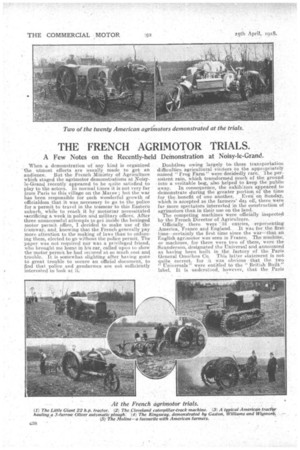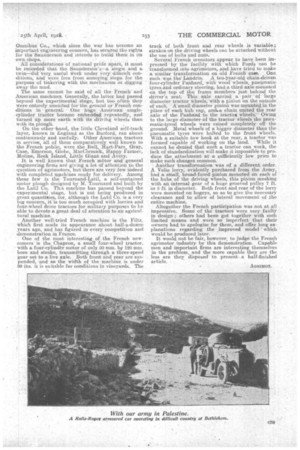THE FRENCH AtRIMOTOR TRIALS.
Page 16

Page 17

If you've noticed an error in this article please click here to report it so we can fix it.
A few Notes on the Recently-held Demonstration at Noisy-le-Grand.
When a demonstration of any kind is organized the utmost efforts are usually. made to set an audience. But the French Ministry of Agriculture which staged the agrimotor demonstrations at Noisyle-Grand recently appeared to be quite satisfied to play to the actors. In normal times it is not very far from Paris to this village on the Maine • but the war has been responsible for such Wonderful growth of officialdom that it was necessary to go to the police for a permit to travel in the tramcar to this Eastern suburb, while to reach it by Motorcar necessitated acrificing a week in police and military offices. After three unsuccessful attempts to get inside the besieged Motor permit office, I decided to make use of the tramway, and, knowing that the French generally pay more attention to the making of laws than to enforcing them, elected.togo without the police permit. The paper was not required nor was. a privileged friend, who brought me home in his car, called upon to show the motor permit he had aecured at so much cost and trouble. It is somewhat slighting after having gone CO great trouble to secure an official document, to find that police and gendarnies are not sufficiently interested to look at it. Doubtless owing largely to, these transporla. tion difficulties agricultural -visitors to the appropriately named " Frog Farm " were decidedly rare. The persistent rain, which transformed much of the, ground into a veritable bog., also helped to keep the public away. In consequence, the exhibitors appeared to demonstrate during the greater portion of the time for the. benefit of one another. Even` on Sunday, which is accepted as the farmers' das, off, there were far more spectators interested in the construction of agrimotors than in their use on the land. The competing machines were officially inspectedby the French Director of Agriculture. Officially there were -7 34 entries, representing America, France and England. It was for the first time—certainly the first time since the war—that an English agrirnotor was seen in France. The machine, or machines, for there were two of 'them,were the Saunderson, designated the' Universal and announced as having been built in the factory of the Paris General Omnibus Co. This latter statement is not quite correct, for it was obvious that the two Universals '.'. were entitled to the " British Built" label. It is -understood, however, that the Paris
Omnibus Co., which since -the war has become an important engineering concern, has secured the rights for the Sauxiderson and intends to build them in its own shops. • .
All -considerations of national pride apart, it must be reeorded that the SaundersedsHa sitigie arid a twin—did Very. useful Work under Very &Moult conditions, and were free from annoying stops for the purpose of tinkering with the mechanism or digging away the mud. The same -cannot be said of all the -French' and American machines. Generally, the latter had passed beyond the experimental stage, but too often they were entirely Unsuited for the ground or Freneh conditions in general: • One -hage American singlecylinder tractor -became embedded repeatedly, and
. turned up More earth with its drivitig wheels than with its plough.
On the other -hand, the little Cleveland self-track layer, known in England as the Burford, ran about
• continuously and usefully. Other American tractors in servioe, all of them comparatively well known to the French public, were -the Bull,. hart-Parr, Gray, Case, Emerson, Globe,IVIacCermick, Happy Farmer, Moline, Rock Island, Little Giant and Avery.
It is well known that French mOtor and. general engineering firms are giving a lot of attention to the question of agrimotors, but there are very few indeed with completed machines ready for.delivery. Among these few is the Tournand-Latil, a self-contained motor plough designed by M.. Tournand and builtby the Latil Co. Ths machine has passed beyond the experimental stage, but is not being produced in great quantities, for, although the Latil Co. is a Very big concern, it is too much occupied with lorries and four-wheel drive tractors for military-purposes to he able to devote a great deal of attention to an agrienttural ranch me.
Another well-tried French machine is the Filtz, Which first made its appearance about. half-a-dozen years ago, -and has figured in every competition and demonstration in France.
One of the most interesting of the French newcomers is the,. Chapron, a small four-wheel tractor, with a, four-cylinder motor of only ,30 mm. by 120 ram. bore and stroke, transmitting-through a three-speed gear set to a live axle. Both front and rear are suspended, -and. as the width of the machine is under 39 ins. it is suitable for conditions in vineyards. The
track of both front and rear wheels is variable ; strakes on the driving wheels caa be attached without the use of bolts and nuts;
Several French inventors appear to have been impressed by the facility with which Fords can be transformed into agrimotors, .and have tried to make a similar transformation on bid French caw. One such was the' Landrin. A ten-Year-old chain-driven four-cylinder Paiiharcf, with woodwheels, pneumatic tyres and ordinary steering, had a third axle mounted on the top of the frame membersjust behind the driver'-s seat. This. akle carried. a .pair of large diameter tractor Wheels,-With a pinion en the outside of each. A small diameter pinion was mounted in the place of each hub cap, and.a chain united the year axle of the Panhard to the tracto* Wheels. "OitTing to the. large diameter of the tractor wheeis the pi-1Rumatie-tyred wheels were raised completely off the ground. Metal wheels of a bigger diameter than the pneumatic tyres were bolted to the front wheels. With a suitable tow hook at the rear, a tractor was formed' capable of working on the land. While it cannot be denied that such a, tractor can work, the lack of standardization will make it impossible to produce the attachment at a sufficiently low price to make such change§ common. .AnOther transformation was of a different order. A Velie lorry, evidently purchased from the Army, had a small, broad-faced pinion mounted on each of the hubs of the driving wheels, this pinion meshing with an-internal gear of a huge grooved pulley 7 ft. or 8 ft. in diameter. Both front and rear of the lorry were mounted on bogeys, so as to give, the necessary clearance and to allow of lateral movement of the entire machine.
Altogether the French participation was not at all impressive. Some Of the tractorS 'were very faulty in -design ; others had been got together with such limited means and were so imperfect that their owners had to apologise for them, and offer long explanations regarding the _improved model which would be produced later.
It would not be fair, however. to judge the French agrimotor industry by this demonstration. Capable men and important firms are interesting themselVes in the problem, and the-more capable they are the less are they disposed to present a half-finished






















